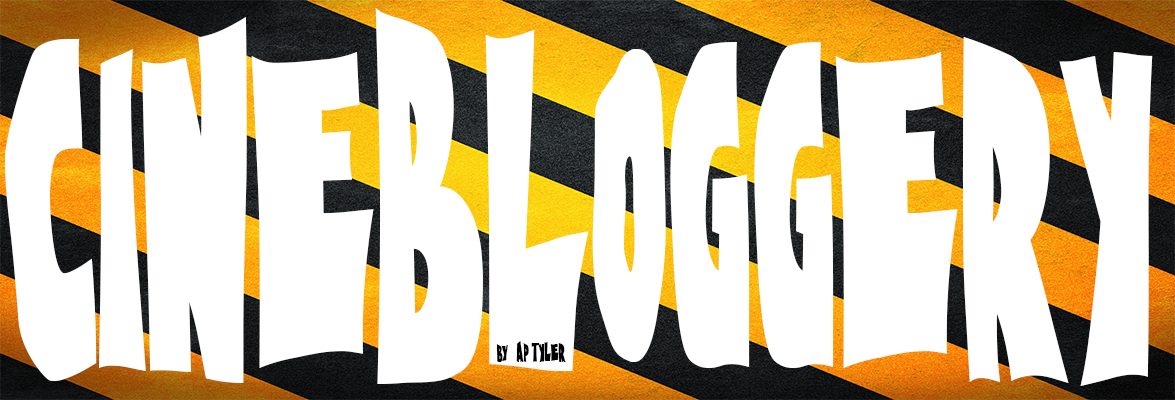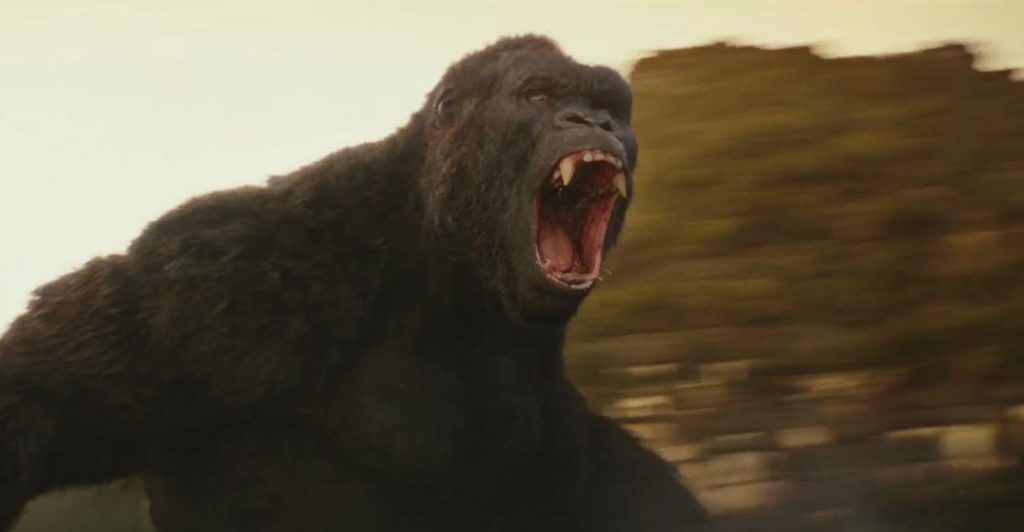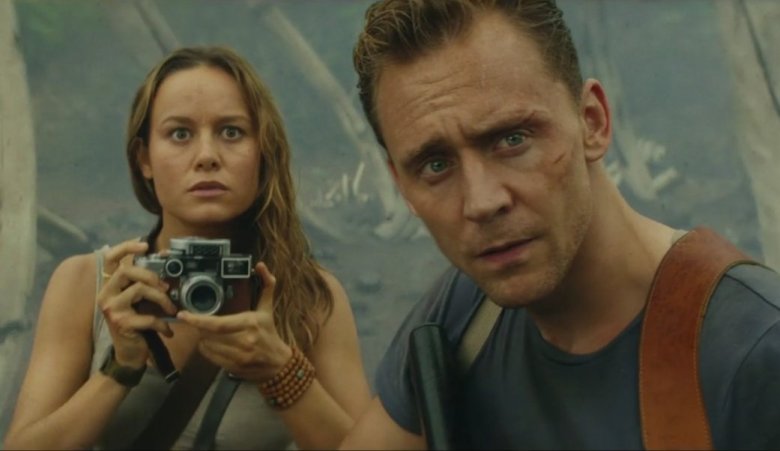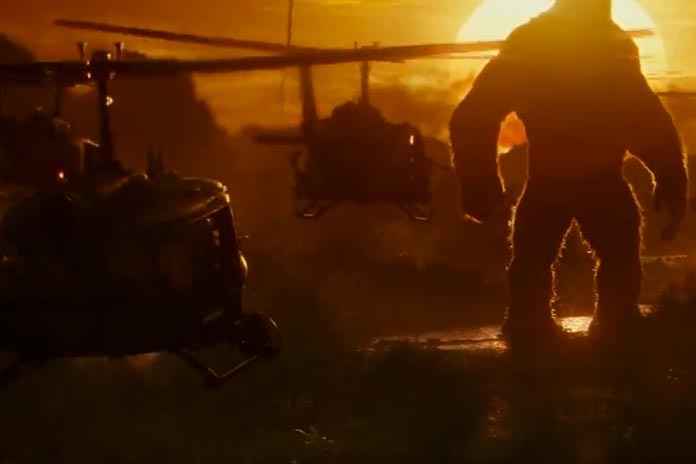I still remember the first time I ever watched King Kong (1933). I have no idea why it was on, or even when, but I distinctly remember being very young, and very confused. The reason I mention this is because when I was a little older and first watched King Kong (1976), I was terrified. I knew vaguely what was happening, but I didn’t know just how far it would take it before giving up.
Add to this the inherent creep factor of 1970s cinema and you have yourself a truly nerve wracking experience. The scene that most sticks with me is Dwan (Jessica Lange) being strung up outside the gates of the tribal village, its inhabitants singing, dancing and chanting the name of their God-King.
Kong Kong Kong Kong Kong
As they bolt the enormous wooden gates closed, the tribe gathers to watch as their human sacrifice awaits her new husband. We see him in glimpses, a shadow passing through the jungle, tearing trees from their roots. When he arrives, the tribe is silent. Dwan looks up and screams. King Kong has arrived – and he is truly terrifying.
You can say a lot of negative things about this iteration of the classic King Kong story, but the execution of this scene is virtually flawless. In comparison, this important scene in Peter Jackson’s King Kong (2005) feels cartoonish and, frankly, a bit embarrassing.
But you’re not here to listen to my opinions of historical creature features, no! You’re here for the new one, available now in 2D, 3D, I-Max and 4DX. You’re here for Kong: Skull Island (2017).
Following an impressive intro of newsreels linking the prologue to the main story, we are introduced to the fact this story is set in 1973 – in the final days of the Vietnam War. Two flustered government officials, Bill Randa (John Goodman) and Houston Brooks (Corey Hawkins), arrive in Washington to beg for additional funding to begin a survey of a mysterious landmass discovered in the Pacific Ocean – aptly named Skull Island.
They clinch the deal, also acquiring a military escort from a recently demobilised helicopter squadron, the ‘Sky Devils’. Led by the jaded Lieutenant Colonel Preston Packard (Samuel L Jackson), Major Jack Chapman (Toby Kebbell) and Captain Earl Cole (Shea Whigham), the Sky Devils are accompanied by a group of nameless scientists, ‘feisty’ photojournalist Mason Weaver (Brie Larson) and former British Special Forces and now adept tracker James Conrad (Tom Hiddleston).
The Price Of A Perfect Protagonist
From the moment James Conrad appeared on screen, I knew I hated him. A self righteous, comically superior protagonist with a whole paragraph describing his personality on Wikipedia, which, incidentally, I’m glad for – having only watched the film I didn’t have any idea of his understanding of conflict, nor his political allegiances. Don’t even talk to me about that scene. You know, when James Conrad is thrown a Japanese sword in slow motion before grabbing a gas mask and inflicting whirling death on a swarm of feral pterosaur-like creatures. Yeah. That scene.
Mason Weaver scores some points for possessing some form of conflict and opinion, but is so void of character and yet so utterly infallible that I couldn’t bear watch her for long periods of time. Like a satire of Nathan Drake and Lara Croft, these characters don’t even feel like characters. They often stand side by side like some sort of character selection screen for the next level, lit like they’re on a omni-gender perfume advert. It was infuriating.
Grr.
But don’t let me get too off topic here, where were we? Ah! Invoking the spirit of Apocalypse Now (1979), the Sky Devils set off toward the island in true helicopter-borne glory. Blasting contemporary rock from mounted speakers and discharging seismic blasts in an attempt to map the island, it isn’t long before they attract some unwanted attention.
Out of nowhere, the helicopters are attacked. A bipedal monstrosity that wastes no time in swatting the helicopters out of the air, crushing them with his bare hands and stamping on the wriggling things inside. Without warning, Kong is there. Right bloody there!
It doesn’t take long before Kong has wiped out the last of the helicopter squadron. As he skulks away, we are left with three groups scattered across the area. Colonel Packard, Bill Randa and a handful of soldiers on one side, while Conrad, Weaver, Brooks and a handful of others on the other, while Major Chapman is even more lost on the west side of the island (while I don’t wish to hand out spoilers, why on earth did they cast such a great actor for this role, then barely use him? Was that a deliberate bait-and-switch or what?).
In classic adventure movie style, each group begin to explore their surroundings, learning more of the island as they go. On one side, the vengeful Colonel that has witnessed his men die at the hands of a wild animal, while on the other, the goodie-goodies being all peaceful and innocent. It is while Conrad, unflappable jungle hero, is leading his group through the wilderness that they discover an ancient tribe. Among them, Lieutenant Hank Marlow (John C. Reilly), a pilot believed lost during the Second World War. Together, they learn the truth of the island and the power of their simian attacker.
At this point, I should say that the film is wearing its classic influences quite firmly on its sleeve. The tone of the story feels very much in line with the classic 1930s monster movie aesthetic, only with more realistic and horrifying creatures in the place of brontosaurus’ and the like. I possibly enjoyed this more than most – the ‘bamboo’ spider scene is particularly effective at making the audience realise just how alien this landscape is.
Combine this with the Vietnam War influences (and a serious Aliens (1986) vibe with those soldier types being picked off left right and centre!) and you have a quite impressive pool to draw from. Unfortunately, I felt all of this good work was ruined by an insistence to crowbar humour in at every opportunity. The tone felt all over the place, while the look and feel of the characters could have been set in any period. It was set in the 70s, but it didn’t feel like the 70s. This was in no way helped by the ever so frustratingly modern take on the direction. Not only did it not fit in with the setting, it felt more like a video game than a movie.
I can understand the difficulty in tone when working with larger-than-life monsters. Finding the right level between campy, comedic and deadly serious is a hard one to find – just look at DC’s latest work – but the humour just felt out of place. By the end of the film, I was baffled as to why the filmmakers thought I should care about Lieutenant Marlow?
All that aside, I enjoyed a fair portion of the movie. I particularly enjoyed Samuel L. Jackson’s character losing his mind (a la Captain Ahab from Moby Dick) and the lengths he would go to for revenge. Likewise, the world building around Skull Island and Kong as a lonely God, fighting for the power of good, was particularly effective. In a not-without-precedent unfair comparison with Gareth Edwards’ Godzilla (2014), Kong: Skull Island succeeded in creating interest in Monarch (yes, I caught the MUTO reference thank you) while also providing the audience with exactly what they wanted:
Big things smashing up littler things.
Yours, A P Tyler



